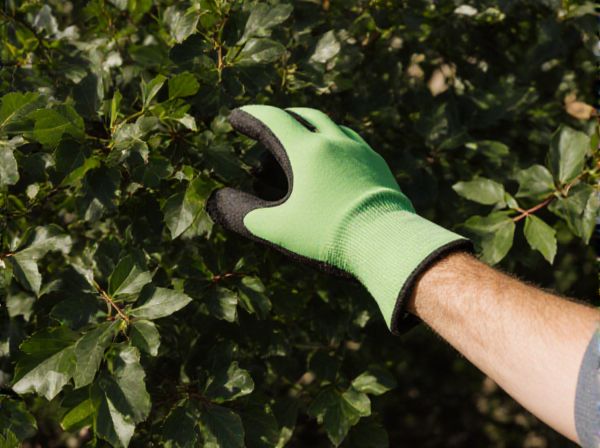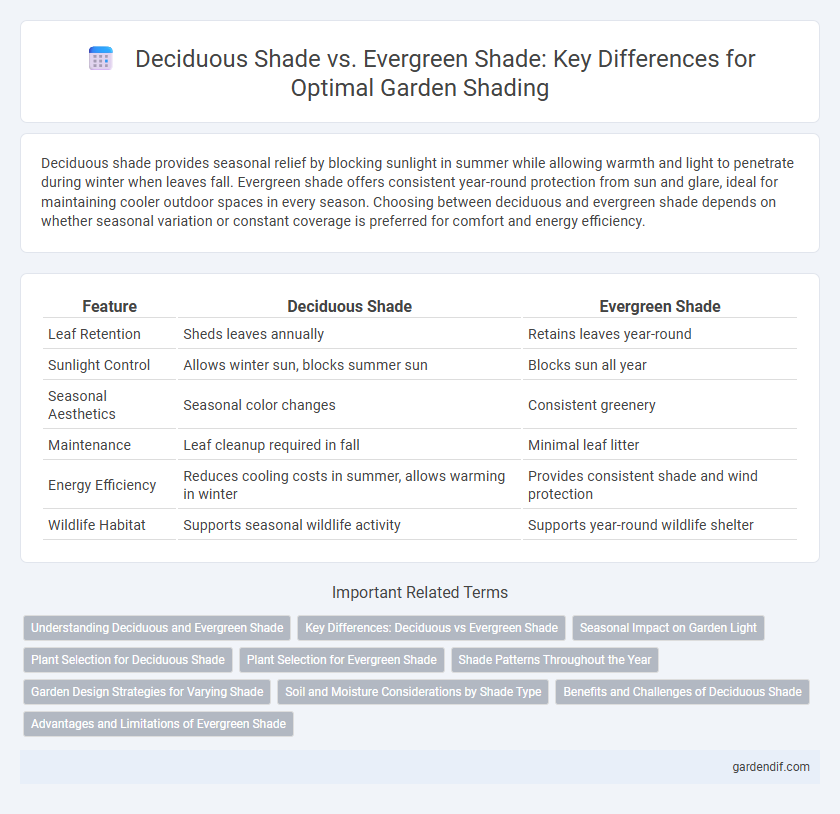
deciduous shade vs evergreen shade Illustration
Deciduous shade provides seasonal relief by blocking sunlight in summer while allowing warmth and light to penetrate during winter when leaves fall. Evergreen shade offers consistent year-round protection from sun and glare, ideal for maintaining cooler outdoor spaces in every season. Choosing between deciduous and evergreen shade depends on whether seasonal variation or constant coverage is preferred for comfort and energy efficiency.
Table of Comparison
| Feature | Deciduous Shade | Evergreen Shade |
|---|---|---|
| Leaf Retention | Sheds leaves annually | Retains leaves year-round |
| Sunlight Control | Allows winter sun, blocks summer sun | Blocks sun all year |
| Seasonal Aesthetics | Seasonal color changes | Consistent greenery |
| Maintenance | Leaf cleanup required in fall | Minimal leaf litter |
| Energy Efficiency | Reduces cooling costs in summer, allows warming in winter | Provides consistent shade and wind protection |
| Wildlife Habitat | Supports seasonal wildlife activity | Supports year-round wildlife shelter |
Understanding Deciduous and Evergreen Shade
Deciduous shade provides seasonal relief by blocking sunlight in summer while allowing warmth through in winter due to leaf loss, promoting energy efficiency in buildings. Evergreen shade offers consistent year-round coverage, maintaining cooler temperatures and shading outdoor spaces regardless of season. Choosing between deciduous and evergreen shade depends on climate, desired sunlight exposure, and energy-saving goals.
Key Differences: Deciduous vs Evergreen Shade
Deciduous shade trees lose their leaves seasonally, allowing more sunlight during winter months, which can help warm homes and reduce heating costs. Evergreen shade trees retain their foliage year-round, providing consistent shade that cools the environment during summer and blocks cold winds in winter. The choice between deciduous and evergreen shade impacts energy efficiency, landscape aesthetics, and microclimate regulation.
Seasonal Impact on Garden Light
Deciduous shade provides variable light conditions by allowing sunlight to penetrate during winter months when leaves fall, promoting seasonal growth cycles in gardens. Evergreen shade offers consistent, year-round coverage, maintaining cooler temperatures and reducing light intensity throughout all seasons. Understanding the distinct seasonal light patterns of deciduous versus evergreen shade helps gardeners optimize plant selection and placement for thriving garden ecosystems.
Plant Selection for Deciduous Shade
Selecting plants for deciduous shade requires choosing species that thrive in seasonal light variations, benefiting from ample sunlight during leafless months and adapting to filtered shade in summer. Ideal plants include shade-tolerant perennials like hostas, ferns, and astilbes, which perform well under the canopy's dappled light. Emphasizing native deciduous understory trees and shrubs such as dogwood and maple enhances seasonal biodiversity while providing effective shade management.
Plant Selection for Evergreen Shade
Selecting plants for evergreen shade involves choosing species that thrive with limited sunlight and maintain foliage year-round, such as ferns, hostas, and hellebores. These plants provide consistent greenery and structure in shaded garden areas, enhancing landscape aesthetics even during winter months. Opting for shade-tolerant evergreens like boxwood or holly also ensures durability and low maintenance in shaded environments.
Shade Patterns Throughout the Year
Deciduous trees provide seasonal shade patterns, offering dense cover in spring and summer while allowing sunlight through bare branches in fall and winter, optimizing energy efficiency. Evergreen trees maintain consistent shade year-round, ensuring continuous protection from solar radiation and reducing outdoor temperatures effectively. Understanding these shade dynamics helps in landscape design for maximizing climate control and comfort throughout all seasons.
Garden Design Strategies for Varying Shade
Deciduous shade provides seasonal variation in garden design by allowing sunlight during winter months when leaves fall, promoting year-round plant diversity and growth. Evergreen shade offers consistent, year-round shelter that supports shade-tolerant plants and creates privacy with dense foliage. Combining both deciduous and evergreen trees within a garden design enables optimized light management and aesthetic balance throughout the seasons.
Soil and Moisture Considerations by Shade Type
Deciduous shade trees allow more sunlight to reach the soil during winter, promoting soil warming and moisture retention, which benefits moisture-sensitive plants. Evergreen shade trees create consistent shade and reduce soil evaporation year-round but can lead to drier soil conditions and acidic soil due to needle litter. Understanding these differences is crucial for managing soil moisture and selecting appropriate underplantings in shaded landscapes.
Benefits and Challenges of Deciduous Shade
Deciduous shade offers the benefit of seasonal sunlight exposure, providing cooling shade in the summer while allowing sunlight to warm spaces in the winter, which enhances energy efficiency in buildings. This type of shade supports diverse ecosystems by enabling understory plant growth during leaf-off periods but presents challenges such as leaf litter management and fluctuating shade intensity. Maintenance requirements can increase due to fallen leaves, yet deciduous shade contributes to air quality improvement and temperature regulation throughout the year.
Advantages and Limitations of Evergreen Shade
Evergreen shade offers consistent year-round coverage, enhancing energy savings by reducing cooling costs in summer and providing windbreaks in winter. The dense foliage of evergreen trees improves air quality and supports wildlife habitats, but their slower growth rates can delay immediate shade benefits. Limited seasonal airflow and potential leaf litter accumulation may create maintenance challenges in some landscapes.
deciduous shade vs evergreen shade Infographic

 gardendif.com
gardendif.com